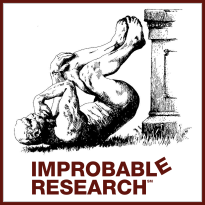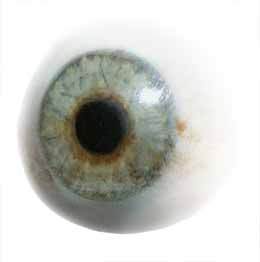Marc Abrahams's Blog, page 337
April 3, 2015
Duct Tape, good for verruca-removal? A review
Some say that the circumspect application of Duct Tape works as a viable verruca-removal method.
Others say it doesn’t. And yet others say that they can’t really be sure. We present below a (partial) listing of professional viewpoints from the medical literature.
Does work (as good as cryotherapy) •
• The Efficacy of Duct Tape vs Cryotherapy in the Treatment of Verruca Vulgaris (the Common Wart) ARCH PEDIATR ADOLESC MED/ VOL 156, OCT 2002
• Is Duct Tape Occlusion Therapy as Effective as Cryotherapy for the Treatment of the Common Wart? JAMA Pediatrics October 2002, Vol 156, No. 10
• Duct tape removes warts. The Journal of Family Practice [2003, 52(2):111-112]
Doesn’t work (no better than a placebo)
• Duct Tape for the Treatment of Common Warts in Adults ARCH DERMATOL/VOL 143, MAR 2007
• Duct tape ineffective in treating warts AAP News, 2007 – Am Acad Pediatrics [sub. reqd.]
• Duct tape of een placebo? [in Dutch] Huisarts en Wetenschap, September 2007, Volume 50, Issue 9, pp 648-654
Can’t really say (evidence is too conflicting to suggest benefit)
• Treating Common Warts: Options and Evidence Australian family physician, 2010 [click full text image to view]
Bonus: Libretto: “La Forza Del Duct Tape” A mini-opera for the 1998 Ig Nobel Prize Ceremony Words by Don Kater and Marc Abrahams, Music by Franz List, Giuseppi Verdi, and Ludwig van Beethoven. This opera premiered at the 1998 Ig Nobel Prize Ceremony, at Harvard’s Sanders Theatre.
Note: Duct Tape was originally called Duck Tape, because it was fabricated using cotton duck (and was water resistant).
Also see: Charming warts Part 1 and Part 2.
April 2, 2015
“The truth behind India’s new GDP numbers”
Pramit Bhattacharya writes, in the Hindustan Times:
The truth behind India’s new GDP numbers
It is an open secret that India’s new gross domestic product (GDP) series has flummoxed most observers of the Indian economy. The new numbers seem completely out of sync with other economic indicators…
As an analysis of 189 nations over 33 years by the Reuters columnist Andy Mukherjee showed, never has an economy had such an handsome improvement in growth even while recording a big improvement in external balances as India claimed to have had in fiscal 2014.
Finally, given the surprising growth numbers, many global investors have begun comparing the state of official statistics in India to that of China. It is important to correct that perception.
In 2014, the Italian government’s National Institute of Statistics was awarded the Ig Nobel prize in economics, for “proudly taking the lead in fulfilling the European Union mandate for each country to increase the official size of its national economy by including revenues from prostitution, illegal drug sales, smuggling, and all other unlawful financial transactions between willing participants.”
The CSO [Central Statistical Office] needs to act fast to restore credibility of official statistics unless it wants to win the Ig Nobel prize for 2015.
Chew on this: Pieces in the polar bear puzzle
“Polar Bears Unlikely to Thrive on Land-based Foods” says the headline in a press release from the US Geological Survey [USGS]. This adds a new piece to the puzzle of what will happen as polar bears more often meet reindeer, as ice melts force the polar bears to spend more time on land.
Compare and contrast the new info (which is detailed in a a review article in the journal Frontiers in Ecology and the Environment) with the findings of the study “Response Behaviors of Svalbard Reindeer towards Humans and Humans Disguised as Polar Bears on Edgeøya” [Eigil Reimers and Sindre Eftestøl, Arctic, Antarctic, and Alpine Research, vol. 44, no. 4, 2012, pp. 483-9].
The humans-disguised-as-polar-bears study was honored with a 2014 Ig Nobel Prize. Co-author Eigil Reimers lectured about his adventures, two weeks ago, as part of the 2015 Ig Nobel EuroTour.
The photo below, by Brian Battaile, is supplied by the USGS:
Podcast #5: The Blonsky centrifugal birthing device
 A birthing machine — that spins a pregnant woman at high speed until the child comes flying out — is on display in this week’s Improbable Research podcast.
A birthing machine — that spins a pregnant woman at high speed until the child comes flying out — is on display in this week’s Improbable Research podcast.
The podcast is all about research that makes people LAUGH, then THINK — research about anything and everything, from everywhere —research that’s good or bad, important or trivial, valuable or worthless. CBS distributes it, both on the new CBS Play.it web site, and on iTunes.
Podcast #3: The Blonsky Centrifugal Birthing Device
LISTEN on Play.it or iTunes. (Or DOWNLOAD it, and listen later)
SUBSCRIBE (to receive a new episode, FREE, every week) on Play.it or iTunes.
This week, Marc Abrahams tells about:
The Blonsky centrifugal birthing device. (“Apparatus for facilitating the birth of a child by centrifugal force,” US patent 3216423, George and Charlotte Blonsky, 1965 / The Bronx Zoo / The Ig Nobel Prizes)
Some pre- and post-Blonsky centrifugal inventions. (Details are in the special Centrifugal Force issue [vol. 20, no. 3, May/June 2014] of the Annals of Improbable Research.)
Inventions inspired by Blonsky. (Details are in the special Centrifugal Force issue of the Annals of Improbable Research.)
Some non-Blonskian birthing inventions. (Details are in the special Centrifugal Force issue of the Annals of Improbable Research.)
To twirl a mental patient. (Details are in the special Centrifugal Force issue of the Annals of Improbable Research.)
On the drying of laundry. (Hansen, Erik B. (1992). ‘On Drying of Laundry.’ SIAM Journal on Applied Mathematics 52 (5): 1360–69. / Chipot, M. (1993). ‘New Remarks on the Dam Problem.’ In Chadam, John M., and Henning Rasmussen, eds. Emerging Applications in Free Boundary Problems: Proceedings of the International Colloquium ‘Free Boundary Problems: Theory and Applications.’ Pitman Research Notes in Mathematics Series 280. Harlow, UK: Longman Scientific and Technical: 2–12.)
Gambling, with brain damage. (Shiv, Baba, George Loewenstein, Antoine Bechara, Hanna Damasio, and Antonio R. Damasio (2005). ‘Investment Behavior and the Negative Side of Emotion.’ Psychological Science 16 (6): 435–39.)
Schizophrenia and heeled shoes. (Flensmark, Jarl (2004). ‘Is There an Association Between the Use of Heeled Footwear and Schizophrenia?’ Medical Hypotheses 63 (4): 740–47.)
The mini-opera “The Blonsky Device”, act 1. (The opera premiered as part of the 2013 Ig Nobel Prize ceremony. Henry Akona orchestrated and directed. The opera starred Maria Ferrante (as Charlotte Blonsky), Martin Kelly (as George Blonsky), Philip Lima (as the zookeeper), and Miles Rind (as the patent examiner), with an orchestra of biomedical researchers directed by Dr. Thomas Michel. Karen Hopkin narrates. The opera also featured, in non-singing roles: Melissa Franklin, , xxx, Peaco Todd, Alex Nemiroski, and Nobel laureates Roy Glauber, Dudley Herschbach, Frank Wilczek, and Eric Maskin.)
The mysterious John Schedler did the sound engineering.
A man who drank too much iced tea
Iced tea can be medically dangerous, if consistently consumed copiously. A new study supplies evidence to that effect:
“A Case of Iced-Tea Nephropathy,” Fahd Syed, Alejandra Mena-Gutierrez and Umbar Ghaffar, New England Journal of Medicine, vol. 372, April 2, 2015, pp. 1377-1378. The authors, at Central Arkansas Veterans Healthcare System and the University of Arkansas for Medical Sciences, report:
“A 56-year-old man presented to the hospital in May 2014 with weakness, fatigue, body aches, and an elevated serum creatinine level (4.5 mg per deciliter [400 μmol per liter])…. He reported not consuming ethylene glycol…. On further questioning, the patient admitted to drinking sixteen 8-oz glasses of iced tea daily. Worsening renal failure with uremic symptoms necessitated the initiation of dialysis…. The case presented here was almost certainly due to excessive consumption of iced tea.”
Here’s visual detail from the study:

Artificial eye iris paints – which to use?
[Question: Why is a paper about artificial eye EYEBALL paints published in the the journal of Brazilian ORAL Research? See below for the answer.]
If you’re an ocularist who creates bespoke hand-painted artificial eyes, presumably durability will be a prime concern. So, the question arises : Which kind of paint is best to colour-in the irises? There are several options available to you, for example: Hydrosoluble Gouache, Hydrosoluble Acrylic, Artist’s Oil Paint, or Nitrocellulose lacquer-based automotive paint. All four of which were examined for durability by a team of investigators from The School of Dentistry*, National University of Brasília, The Department of Dental* Materials and Prosthesis, School of Dentistry* of Araçatuba, São Paulo State University, and the School of Chemical Engineering of Lorena (FAENQUIL), Lorena, Brazil. Specially fabricated eye-like swatches were coated with the four paints (in both blue and brown) and then exposed to an accelerated ageing process using exaggerated humidity levels, accompanied by strong UV light. The conclusions: [artists’ oil paint wins]
• Hydrosoluble acrylic, hydrosoluble gouache, nitrocellulose-based automotive and oil paints present numerical chromatic alteration when submitted to accelerated aging by ultraviolet radiation and water condensation.
• The brown color presented statistically significant higher chromatic stability when compared with the blue color, irrespective of the paint and period of aging assessed.
• The oil paint has excellent and significant chromatic stability for use in painting artificial irises for prosthetic eyes polymerized by microwave
energy, irrespective of color, when compared with the other paints assessed.
• Artificial eyes fabricated with dark pigments have a longer lifetime use.
See: Color alteration of the paint used for iris painting in ocular prostheses Brazilian Oral Research, vol.23, no.4, Oct./Dec., 2009.
*Note: Explaining, perhaps, why the paper was published in the journal of Brazilian Oral Research.
Also see: Artificial eyes, a look back
April 1, 2015
Should packaged meat labels include pre-slaughter rectal-temperature info?
A new study inspired the until-now unasked question: Should packaged meat labels include pre-slaughter rectal-temperature info?
The study does not itself overtly ask that question. The study is:
“Pre-slaughter rectal temperature as an indicator of pork meat quality,” L. Vermeulen, V. Van de Perre, L. Permentier, S. De Bie, and R. Geers, Meat Science, vol. 105, July 2015, pp. 53–56.
March 31, 2015
Plush Dissected Knit Creatures and Other Scientific Wonders
For several years, people have been able to experience the joys of plush microbes (these are awesome), plush subatomic particles, and even plush statistical distributions.
Well, for people who are more into anatomy — or who want a soft way of learning about it — you can also get plush versions of dissected animals (and other creatures).

(Thanks to Leslie Porter for bringing the knit dissected creatures to our attention. Some of us are already proud owners of plush microbes, statistical distributions, etc.)
Stirring rendition of “Shake It Off”, by Cornell chemists
Chemists at Cornell University concocted this video tribute to both (1) chemistry and (2) Taylor Swift’s music video “Shake It Off”:
Here’s Taylor Swift:
(Thanks to investigator Michelle Kearns for bringing this to our attention.)
Ig Nobel Prize-winning research produces tear-less onions
Chemistry research that led to an Ig Nobel Prize has now led to an onion that does not cause tears, reportedly. The Wall Street Journal‘s JapanRealtime blog reports:
No Crying in the Kitchen: Japan Firm Engineers Tear-Less Onions
House Foods Group Inc. knows its onions.
The Japanese food maker, whose researchers have been studying the chemistry of onions for more than a decade, on Monday said it has developed onions that produce an extremely low amount of enzymes which creates compounds that make so many cooks tear up when chopping the vegetables raw….
House Foods’ researchers won the Ig Nobel Prize in chemistry in 2013 for discovering the biochemical process of how onions brings tears to the eyes. Their study was published in Nature magazine in 2002.
The news is reported in many other places, among Le Pointe, which boasts the headline “Quand les oignons ne nous feront plus pleurer !“
Marc Abrahams's Blog
- Marc Abrahams's profile
- 14 followers





